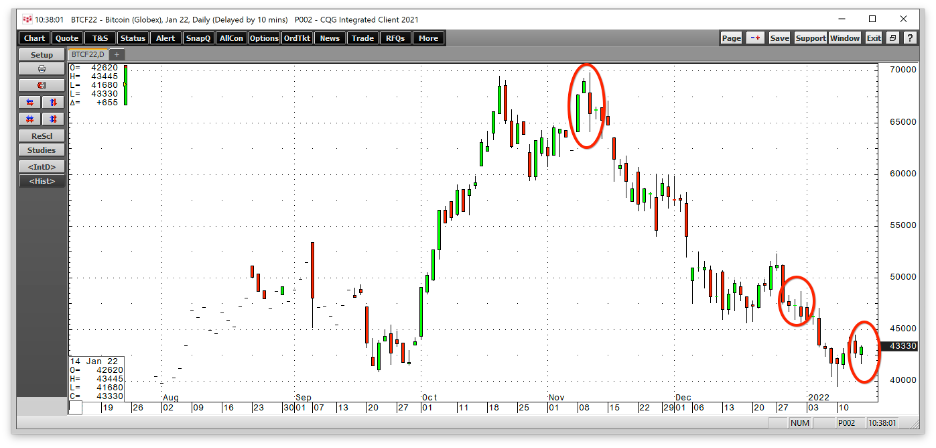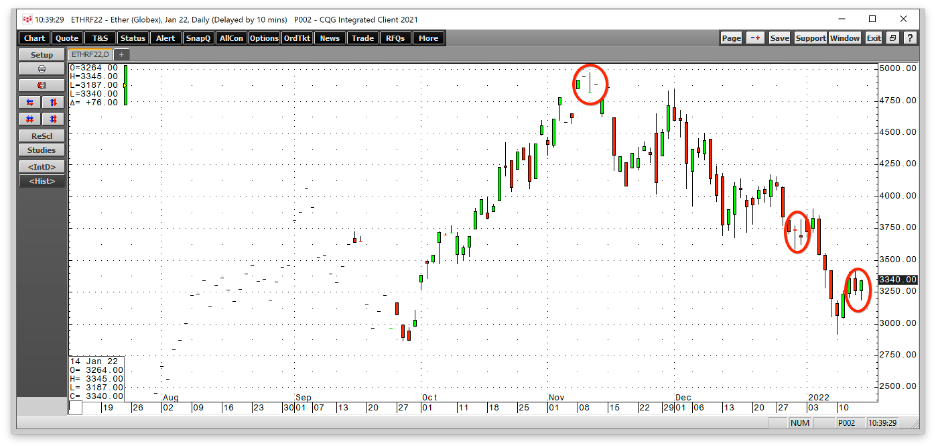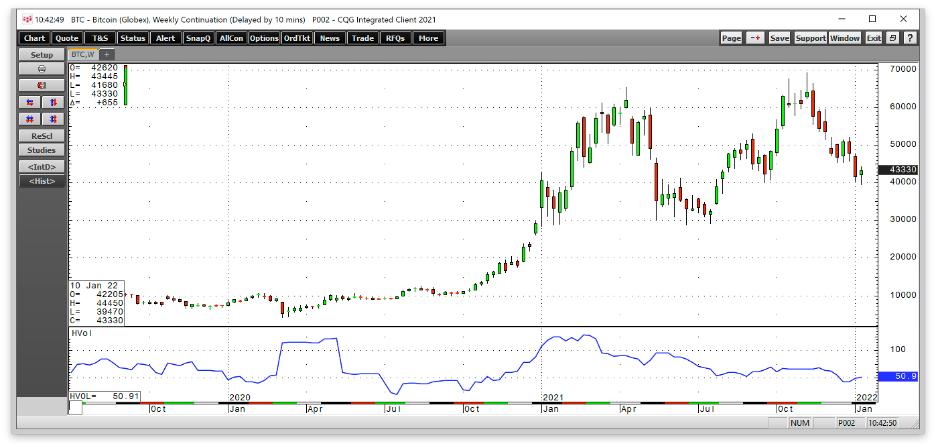This article was written exclusively for Investing.com
- An ugly start to 2022
- Volatility is the hallmark of the asset class
- Inflation is not going away anytime soon and will continue to erode fiat currency values
- Fintech and inflation - Cryptos provide an alternative
- Bitcoin and Ethereum will find bottoms - The bull market is not over
The US Federal Reserve abandoned the characterization of rising inflation as “transitory” at the December FOMC meeting. After President Biden nominated Chairman Powell for a second term, and in the aftermath of the latest consumer price index data, the Fed accelerated tapering quantitative easing, setting the stage for liftoff from a zero percent Fed Funds rate as early as the March 2022 FOMC meeting.
In the early days of 2022, the central bank has gone back and forth about reducing its balance sheet. Still, the December FOMC minutes reflected that moving from quantitative easing to quantitative tightening is possible over the coming months.
Inflation weighs on fiat currency values as it erodes purchasing power. The declines in the dollar, euro, pound, yen, and other fiat currencies that derive their value from the full faith and credit in the governments that issue legal tender is not readily apparent when measuring one foreign exchange instrument versus another. However, the fiats have lost value when measured against stocks, commodities, real estate, and cryptocurrencies in 2021.
Cryptocurrencies are an alternative to other means of exchange that reflect a libertarian economic ideology. While central banks, treasuries, monetary authorities, and governments can expand and tighten monetary policy to impact the money supply, cryptocurrencies are different. Crypto values depend on supply and demand established by market participants without government interference. Therefore, inflationary pressures likely caused the over 180% rise in the asset class’s market cap in 2021.
Bull markets rarely move in a straight line, and corrections can be swift and brutal. In a volatile asset class like cryptos, the price action has been nothing short of head-spinning, and the cryptocurrency asset class has started 2022 on a bearish note.
An ugly start to 2022
The leading cryptocurrencies and the asset class’s market cap began falling on Nov. 10 and continued to move lower so far in 2022.
Source: CQG
As the chart illustrates, January Bitcoin futures put in a bearish key reversal trading pattern on Nov. 10 when the price reached a high of $69,820 and closed below the previous day’s low. On Dec. 31, 2021, the futures closed at $46,275, and at the end of last week, the leading cryptocurrency was at the $43,330 level, 37.9% below the Nov. 10 high.

Source: CQG
January Ethereum futures reached a high of $4,972.75 on Nov. 10, put in the same bearish pattern, and closed 2021 at the $3,685 level. At $3,340 on Jan. 14, Ethereum was 32.8% below its mid-November record peak.
Meanwhile, the cryptocurrency asset class’s market cap was $2.166 trillion on Dec. 31 and stood at $2.091 trillion on Jan. 17, a 3.5% decline so far in 2022. Bitcoin and Ethereum are 6.4% and 9.4% lower, respectively, in 2022. The leading cryptos have underperformed the asset class so far this year as other tokens have done better than the two dominant cryptocurrencies.
Volatility is the hallmark of the asset class
Market participants are accustomed to wild price swings in the cryptocurrency asset class, with token prices routinely doubling, tripling, and more than halving in value. 
Source: CQG
The weekly Bitcoin futures chart shows that weekly historical volatility traded between 42.57% and 128.50% in 2021. At the 50.9% level on Jan. 14, the price variance metric was closer to the low than the high since the beginning of 2021.
Source: CQG
Ethereum futures began trading in February 2021. Weekly historical volatility traded from a low of 38.92% to a high of 149.95% from February through December 2021. At the 49.7% level on Jan. 14, weekly Ethereum volatility was also near the low.
The decline in price variance shows that the leading cryptos are consolidating after the moves from the Nov. 10 high. While both made lower lows in early 2022, the price action has calmed, with Bitcoin and Ethereum prices recovering from the recent bottoms.
Inflation is not going away anytime soon and will continue to erode fiat currency values
Last week, the US Bureau of Labor Statistics reported that the consumer price index rose in December, reaching 7% in 2021. The core inflation barometer that excludes food and energy was at 5.5%. The Fed’s inflation target is an average of 2%. The producer price index rose by nearly 10% in 2021.
The central bank has accelerated tapering quantitative easing, which looks set to end in March 2022, setting the stage for liftoff from a zero percent short-term Fed Funds rate. Moreover, the Fed has discussed reducing its balance sheet, which involves allowing debt securities to roll off its swollen balance sheet when they mature. Balance sheet reduction would move the central bank from quantitative easing to quantitative tightening, encouraging higher interest rates further along the yield curve.
Meanwhile, the FOMC’s most recent forecasts call for a 0.90% Fed Funds rate in 2022 and 1.60% in 2023. Even if inflation begins to recede, which is no certainty, short-term real interest rates will remain negative throughout 2022 and perhaps in 2023. The real rate of interest is current rates minus the rate of inflation.
Inflation eats away at money’s purchasing power. Over the past nearly two years, central bank liquidity, government stimulus, and pandemic-related supply chain issues lit an inflationary fuse that will be challenging to extinguish. Moreover, a labor shortage forcing wages higher is feeding the inflationary fire.
Fintech and inflation - Cryptos provide an alternative
The fintech revolution has increased the speed and efficiency of banking and finance. Fintech’s evolution includes the new means of exchange, cryptocurrencies. Governments are notoriously slow-moving institutions. The US Fed’s response to inflation is a perfect example of a delayed reaction to an economic event. People tend to vote with their pocketbooks and wallets. The faith in government institutions has declined as inflation rose over the past months.
Fintech addresses speed and efficiency. It should come as no surprise that cryptocurrencies have become inflation-sensitive instruments. Since governments have not interfered in the markets, the value is a function of buying and selling in the market. Moreover, while governments can issue fiat currencies to their hearts' content, crypto supplies are only expanded by mining activities.
With inflation at the highest level in four decades, cryptocurrency values will likely find bottoms and resume their upward trajectory.
Bitcoin and Ethereum will find bottoms - The bull market is not over
Bull markets rarely move in straight lines, and corrections can be brutal. The decline in Bitcoin from nearly $70,000 to below $40,000 per token at the most recent low is an example of how corrective price action can shake the faith of even the most devoted bull.
However, cryptos are not the only markets that experience severe bull market corrections. NYMEX crude oil futures fell from a high of $85.41 in late October to a low of $62.43 in early December, a 26.9% drop in six weeks. COMEX copper futures traded from a high of $4.8985 per pound in May 2021 to a low of $3.9615 in August, a 19.1% decline in three months. Lumber futures moved from $1711.20 in May 2021 to a low of $488 per 1,000 board feet in August, a 71.5% correction.
Commodity prices have recovered since reaching the lows, and I suspect that Bitcoin, Ethereum, and other cryptocurrencies are on the same path. Inflation erodes money’s purchasing power, and we measure the value of cryptocurrencies and other assets in dollar terms. Elevated inflation and negative real interest rates are likely to lead to a continued pattern of higher lows and higher highs in cryptocurrencies and many other asset classes.
